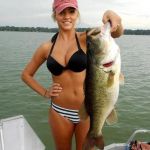Not a member of Pastebin yet?
Sign Up,
it unlocks many cool features!
- Fishing isn't an exact science, and neither is picking a lure. But there are lots of tips out there to point you in the right direction. The Imgur album has some infographics that may help you pick the right lure, but every lake is different, every day is different, and every fish is different. Trial and error is honestly the best way to find out what works for you in what conditions.
- First step to choosing the right bass lure would probably be to determine the water temp. Cold water means the bass are moving slow and they aren't likely to chase a school of fast moving baitfish, so I wouldn't pick a big spinnerbait with 3 blades that replicates baitfish when you go out to the lake on that first 60F day in March. The same is also true when the water gets too warm. In July and August when the water temps get really high, bass don't like to chase large, fast lures. I ain't no scientist, but something about metabolism where it gets higher so they try not to be too active and burn up all of their energy chasing difficult prey. With lazy fish, the catch will never be as good as the pre-spawn frenzy. But if you want a chance of having a good day at the lake, finesse presentations normally work better. The soft bait rigs like Texas rigs, shakey heads, wacky rigs, and drop shots are good choices. Some hardbaits will work too if you get the action right. Suspending jerk baits like Rapala Husky Jerks can be fished slow and mimic a wounded baitfish and look like an easy meal for a lazy bass. And when picking a bait, sometimes smaller is better on these days. A thin 6" Zoom Finesse Worm might work better than some big 8" Magnum Lizard or crawdad. Same with the hard baits; if a 4lb bass is moving slow, it may prefer a 2.5" jerkbait over a big meal like a Size 12 Rapala.
- When you have more mild water temps and the bass are moving and actively hunting, you can pretty much use anything in the tackle box. Spinnerbaits or rattling lipless cranks in a natural silver and gold will draw attention to themselves and bring bass in from farther distances. At dawn or dusk on these days, run a spinnerbait along a drop off or just on the deep end of some cover and you should have some fun.
- Once you find the right type of bait, you have to pick the proper color which can be even more confusing. Natural gold is probably my #1 for almost all conditions since it is flashy enough to get attention but won't scare fish away on a sunny day with clear water when a shiny silver lure can become a disco ball. White is also a great color for all sorts of conditions. When fishing lakes with decent visibility, you can't go wrong with replicating natual prey and their colors. If the water is murky, this is where it can get interesting. While it seems odd, using a dark black or blue bait in muddy water will often outperform flashy silver baits. Bass see contrasting colors well, as well as some science stuff where certain colors are more visible under low light, so a Junebug soft plastic will stand out against a brown or green background.
- And then there is chartruese... I still haven't figured that out. While it doesn't look like any natural bait, bass can't resist chartruese on certain days. Some of my best catches have been in fairly clear water with chartruese pepper Zoom lizards. And I seem to do well with that color when I'm fishing the canals that have good visibility but the water is stained brown from trees or other sources. So it's worth having some chartruese baits in the tackle box because there are lots of days where nothing normal is working but the bass can't resist the bright yellow.
- For night fishing, bass are going to rely on sound and vibrations when hunting for prey. This is when spinners, rattlers, and topwater will land you some good ones. As mentioned before, dark colors like purple and black are actually more visible to the fish in low-light conditions so many lures designed for night fishing will be black. Mepps Black Fury inline spinners are one of my go-to baits ar night. Remember that when it comes to spinners, different blades do different things. Big round blades like Colorado blades or French blades will make a lot of noise and tend to run fairly shallow. Willow blades are longer and thinner and create less sound but run deeper. More noise isn't always better, but often times at night you will catch more running Colorado blades instead of Willow blades. Topwater is always a blast and just after sunset can be a great time to use those. If the water is super calm and quiet, you don't need to use the loudest and most flashy propbait or buzzbait, a Spook-type walking bait might be plenty. If you want a little more, go with a popper or a frog. Trial and error.
- Remember that different lures are fished in different ways. A steady, medium speed retrieve won't work as well as the correct presentation that makes the lure look like a live meal. Youtube is your friend when you want to try a new type of lure.
- The best way to find the right lure it to try yourself. Asking experienced local anglers or your nearby tackle shop is also a great way to figure out what is catching fish at that time of year.
Add Comment
Please, Sign In to add comment

